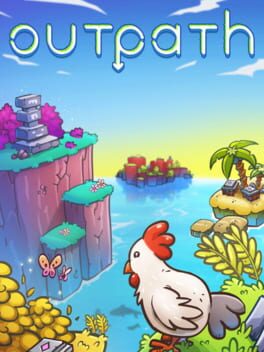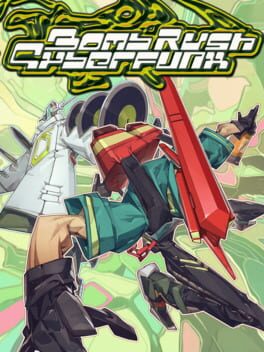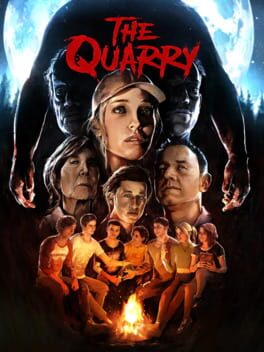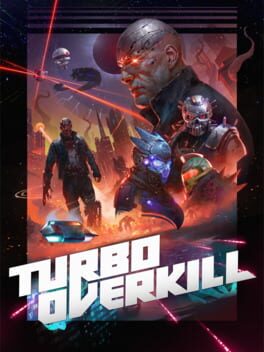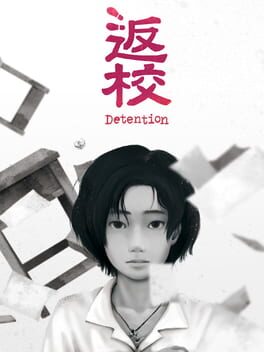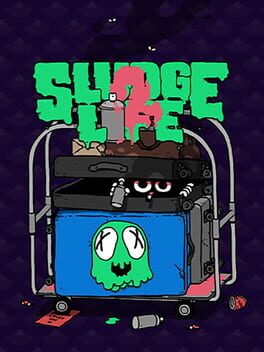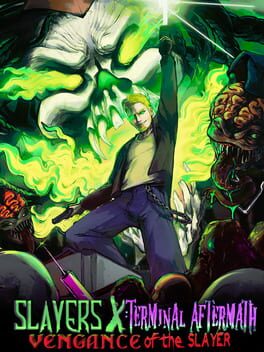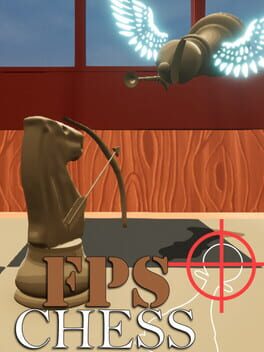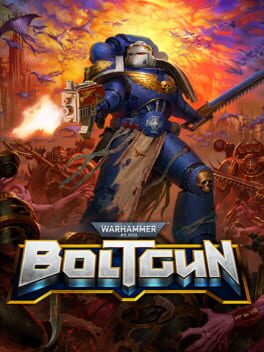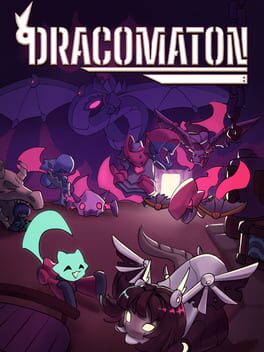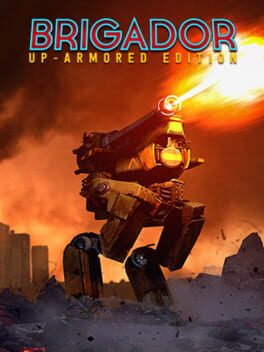AuTomaton
2023
2023
2023
The vibes are immaculate. The friends are the best. The drip is incomparable. The game allows players to intentionally trick out very quickly but that low skill ceiling limits how the player can express themselves which in the short term lets players fall into the play-fantasy a street performance king but I feel ultimately holds the player back from conquering New Amsterdam on their own terms. The art is pretty. I have never played Jet Set Radio.
2022
2022
Turbo Overkill's damage calculus works against the game very hard. All attacks (and I mean all, your attacks and enemy attacks) either do inconsequential damage or instantly kill the target. From the player side, this means most weapons are not worth caring about. Out of an arsenal of 10 weapons, only 4 are generally applicable to combat. There's nothing wrong with a 4 weapon arsenal necessarily, but why were the other 6 added? For a damage niche that that doesn't exist? To add resources to an already over-saturated ammo economy where you have to try to run out of bullets? The remaining 4 weapons are effective, but they're SO effective that basic use with the player's abilities would make most combat encounters arbitrarily easy. It at least makes most individual fights not worth thinking about.
I say 'would' because getting grazed by anything larger than you is usually an instant kill. Turbo Overkill gets some grace here because its respawn time is refreshingly low, and a majority of enemies are the man-sized ones who only exist to pad level enemy counts, so it's a manageable problem from a play perspective. The issue is the breakpoint instant kills create means most resource management is meaningless. If everything important kills you in one shot, why bother having health or armor? Players that figure this out can probably spec into a very effective glass-cannon playstyle, which is cool! But I feel that Turbo Overkill expects player health to be a much more closely managed resource. If players were supposed to be gibbed so fast by enemies, why are Rammers the only enemies with non-visual attack queues?
And, you know, getting the death BSOD with no feedback is kinda annoying.
Turbo Overkill's gameplay does not have a middle ground between being alive and not, but provides tools that are applied almost exclusively to that middle ground. The game wants to give the players tools to explore gameplay depth that doesn't exist. The best the player can do is autopilot between threat vectors until every enemy worth caring about is dead or they've been respawned.
There're a lot of other problems with Turbo Overkill regarding its movement being weird and contextually sluggish, and its presentation being kinda sloppy, and the writing being really not that great, but the whole "complexity-erasing damage" thing is the big one to me.
I say 'would' because getting grazed by anything larger than you is usually an instant kill. Turbo Overkill gets some grace here because its respawn time is refreshingly low, and a majority of enemies are the man-sized ones who only exist to pad level enemy counts, so it's a manageable problem from a play perspective. The issue is the breakpoint instant kills create means most resource management is meaningless. If everything important kills you in one shot, why bother having health or armor? Players that figure this out can probably spec into a very effective glass-cannon playstyle, which is cool! But I feel that Turbo Overkill expects player health to be a much more closely managed resource. If players were supposed to be gibbed so fast by enemies, why are Rammers the only enemies with non-visual attack queues?
And, you know, getting the death BSOD with no feedback is kinda annoying.
Turbo Overkill's gameplay does not have a middle ground between being alive and not, but provides tools that are applied almost exclusively to that middle ground. The game wants to give the players tools to explore gameplay depth that doesn't exist. The best the player can do is autopilot between threat vectors until every enemy worth caring about is dead or they've been respawned.
There're a lot of other problems with Turbo Overkill regarding its movement being weird and contextually sluggish, and its presentation being kinda sloppy, and the writing being really not that great, but the whole "complexity-erasing damage" thing is the big one to me.
2017
The mixed-media visual presentation incorporates very timely material evocative of post WWII regime terror. It ties what the player sees in-game into the visual tropes they have in their head about what such a time period looks like in history books, and that's a fantastic bias to tap into.
Detention itself, though, doesn't do much for me. The contrast of Ray's real-life responsibility for her actions and her internal sense of helplessness is presented well visually (grimy post-war collapse vs abstract nightmare-scapes), but that's the only area where Detention can stand on its own. The metaphorical nature of Detentions puzzles is vital to understanding what the game wants to say, but they become worse and worse at communicating as the game goes on.
This game might resonate better with people who can relate better to Ray's condition, and that's alright. Being able to empathize with Ray, rather than simply pitying her, is probably a big part of the emotional pull of this game.
Detention itself, though, doesn't do much for me. The contrast of Ray's real-life responsibility for her actions and her internal sense of helplessness is presented well visually (grimy post-war collapse vs abstract nightmare-scapes), but that's the only area where Detention can stand on its own. The metaphorical nature of Detentions puzzles is vital to understanding what the game wants to say, but they become worse and worse at communicating as the game goes on.
This game might resonate better with people who can relate better to Ray's condition, and that's alright. Being able to empathize with Ray, rather than simply pitying her, is probably a big part of the emotional pull of this game.
2023
It really is Sludge Life twice. Sludge Life 2 tunes down the helpless juvenile antics of Ghost and matures them into intentional resistance and growth. It gives Ghost a character of having grown up since Sludge Life, in that they put down or pick up the paint as a tool to change their situation instead of tagging because that's all they have.
2020
SLUDGE LIFE's beauty is in how ugly it is. Many games that live a streetpunk/societal collapse/urban decay lifestyle are very pretty or aesthetic or "livably interesting". SLUDGE LIFE is a smog-choked, pollution swamped, actively-in-crisis place. Living in the environment of SLUDGE LIFE is not pleasant. Ghost is not punky scamp, they are an actively destructive shitbag who negatively effects the society they live in. But in spite of that, the people of the sludge island still hold their lives. They find beauty in stolen laundry machines and cigarettes and pool showers. The island is small and limiting in the same way a collapsing drive-through town is. Its grimy beauty feels more real to me because of that. The island isn't realistic, but it is "real".
Stay easy, I guess.
Stay easy, I guess.
Slayers X: Terminal Aftermath - Vengance of the Slayer is very hard to interpret with how meta its presentation is supposed to be. The faithful artistic rendition of a late 90s loser's idea of blockbuster video game that will catapult him to fame and wealth and justify his massive ego is perused and achieved with the same level of realness as its predecessor in Hypnospace Outlaw. What snags me is not any of the creative aspirations of Slayers X, it's playing it. Slayers X is still a first person shooter with enemies to shoot and maps to beat and maybe I just don't get it 'cause I was born after Limp Bizkit's Significant Other came out but Slayers X only plays fine.
I could list out all of the game's mechanical faults, but would that be a genuine thing to? If we take the game's meta-narrative at face value, Slayers X was made by 2 dudes in their 40s on minimum wage. Is the game's less-than-stellar gameplay design a legitimate issue with the game, or an artistically intentional manifestation of that fiction?
I don't really know. Sorry!
I could list out all of the game's mechanical faults, but would that be a genuine thing to? If we take the game's meta-narrative at face value, Slayers X was made by 2 dudes in their 40s on minimum wage. Is the game's less-than-stellar gameplay design a legitimate issue with the game, or an artistically intentional manifestation of that fiction?
I don't really know. Sorry!
2022
Armored Core 6 is pretty easy and pretty shallow for an Armored Core game. Those two things are not necessarily bad; AC6 is probably the only AC game I'd recommend that isn't weirdly obtuse about everything. But AC6 slims things down to the point of losing some of the intricacy of its predecessors, and it creates a less interesting build experience. A less player-intensive experience, combined with AC6's easier levels and focus on 'monster' bosses, does not leave enough room for skill growth to allow players to become their own 'style' of master AC pilot. That is to say, AC6 is so easy and focused on scripted game beats that players do not get to express themselves as much in-game. If Armored Core's biggest problems are esoterica and difficulty, then Armored Core 6 over corrects for these issues. I look forward for the pendulum swinging back the other direction while I mad-rush S ranks like I need the COAM in my blood.
BOLTGUN's art has a very unique painted-plastic look for its weapon and enemy sprites that I absolutely adore. The models aren't just pixel renditions of miniature shapes; the way the painted on light 'reflects' around the edges of the sprites make your enemies feel like they're made of plastic. Super imaginative, and a fun nod to the source material.
There's not much else positive to say about BOLTGUN. The static, winding environments and cookie-cutter enemies creates a firing range rather than engaging levels to play. The player's many tools for movement and attack are bland at best and redundant at worst. The game is extremely easy. It's a blend of quantity over quality that doesn't progress into any interesting mechanical play or narrative moments.
Plus, WH40K's traditional bent towards the horror of ceaseless war and the nightmarish cruelty of unending conflict are thrown out here in the name of the Ultramarine power fantasy. Not like you should expect avaunt guard experience here, but there's no artistic meaning to glean from this game either.
There's not much else positive to say about BOLTGUN. The static, winding environments and cookie-cutter enemies creates a firing range rather than engaging levels to play. The player's many tools for movement and attack are bland at best and redundant at worst. The game is extremely easy. It's a blend of quantity over quality that doesn't progress into any interesting mechanical play or narrative moments.
Plus, WH40K's traditional bent towards the horror of ceaseless war and the nightmarish cruelty of unending conflict are thrown out here in the name of the Ultramarine power fantasy. Not like you should expect avaunt guard experience here, but there's no artistic meaning to glean from this game either.
2022
Fashion Police Squad's diverse enemy and level set is pair with a low-power and limited Simon-Says arsenal. FPS' encounters are based entirely on matching the weapon you're holding to the enemy in front of you, and provides very few tools to actually decide how you can approach a combat encounter other than the order in which you attack enemies. The time and resources spent in an encounter are much more tightly coupled to the enemies in the encounter than the player's ability to deal with them. It leaves very little for the player to learn and work with, and it creates a slow laborious experience of needing to wait out specific enemy health bars before you can deal with a different specific enemy health bar.
2023
Dracomaton's Forms System is a great response to the roguelike conundrum of getting stuck in equipment ruts. The mechanical advantage of cycling out forms allows the player to encounter interesting synergies and strategies more naturally than having hard usage limits and more frequently than just letting the forms be. Forms scale very slowly, so while it's hard to experience equipment discovery early in the game, players still get the chance to learn about which forms and mods work best for their equipment and play style. The only time slow early form scaling hurts is high-speed runs, where players might get locked into unhelpful form options early game and miss the DPS targets they need to stay on pace.
Foundationally, Dracomaton is rock solid. Almost all of its flaws have to do with the limited scale of its production. Enemies have a bit too much health, room geometry has a bit too many snags, things that wouldn't have survived an in-depth polish phase that Dracomaton probably wasn't able to receive. Technical performance is a trouble spot, though. Dracomaton's bugs and performance issues aren't so intense that the game is hard to play through them, but players will need to keep the possibility of intense lagspikes or phantom inputs in mind if they want to play a higher-risk build.
Foundationally, Dracomaton is rock solid. Almost all of its flaws have to do with the limited scale of its production. Enemies have a bit too much health, room geometry has a bit too many snags, things that wouldn't have survived an in-depth polish phase that Dracomaton probably wasn't able to receive. Technical performance is a trouble spot, though. Dracomaton's bugs and performance issues aren't so intense that the game is hard to play through them, but players will need to keep the possibility of intense lagspikes or phantom inputs in mind if they want to play a higher-risk build.
Brigador is an unfolding tactical lotus that is always hiding something. At first, it hides unit types, and weapon synergies, and lore, and those other kinds of mechanical things. Once those mechanical things are exhausted, Brigador begins to unfold how it's supposed to be played. There are suggestions, ideas, a "feel" of an intended gameplay experience, but Brigador continuously removes smaller and smaller training wheels and begs the player to ask "Okay, but what if I just full fucking send it?" with a wider and wider spreading of mechapunk murderdeath. Every time you thing you've found Brigador's intention, the lotus opens again and you realize you could have been doing better the whole time.
With this in mind, the game is built not to be a mecha twin-stick shooter, or a tactical stealth game, but as a sandbox. Brigador is a sandbox with a very specific kind of sand in a very specific kind of box. Can you only build the biggest sand castles with quiet, tactical, high-risk, and high-precision stealth builds? Yes. But as long as it involves shooting robots in 3ish dimensions, you can spin Brigador to make it happen.
Brigador's constant lotusing and unfolding start buckling at higher difficulties, though, and it can only go so far. The 'correct' way to play Brigador is whatever way is the most fun, but the 'best' way is stealth. While this has no meaningful consequence in Freelance (due to how silly payout scaling is with certain pilot/vehicle combos), it's hard to cope with in Campaign mode. Is that a skill/personal issue? Mostly, yes, but it also means the later you get into the campaign a player gets, the more the game zooms in on high-risk low-reward stealth play. It's not a terrible place to end up in; Brigador always has an undercurrent of tactical stress. There's simply a loss of player expression in the later campaign that the rest of the game doesn't struggle with.
With this in mind, the game is built not to be a mecha twin-stick shooter, or a tactical stealth game, but as a sandbox. Brigador is a sandbox with a very specific kind of sand in a very specific kind of box. Can you only build the biggest sand castles with quiet, tactical, high-risk, and high-precision stealth builds? Yes. But as long as it involves shooting robots in 3ish dimensions, you can spin Brigador to make it happen.
Brigador's constant lotusing and unfolding start buckling at higher difficulties, though, and it can only go so far. The 'correct' way to play Brigador is whatever way is the most fun, but the 'best' way is stealth. While this has no meaningful consequence in Freelance (due to how silly payout scaling is with certain pilot/vehicle combos), it's hard to cope with in Campaign mode. Is that a skill/personal issue? Mostly, yes, but it also means the later you get into the campaign a player gets, the more the game zooms in on high-risk low-reward stealth play. It's not a terrible place to end up in; Brigador always has an undercurrent of tactical stress. There's simply a loss of player expression in the later campaign that the rest of the game doesn't struggle with.

